Caravaggio: Your city guide to see all works of Rome’s greatest Baroque painter and famous all-around rebel

My hero is a murderer.
He’s also dead, along with Wilt Chamberlain, my childhood idol. However, like Chamberlain, this man inspired me with his fierce independence as much as his enormous talent and an image bigger than life. His fame dwarfs the 7-foot-1 Wilt’s and gets bigger with each passing year.
It’s 408 years and counting.
I’ve admired Caravaggio, Italy’s greatest Baroque painter, ever since I first lived in Rome in 2001. An old baseball writer colleague, Mark Saxon, lived here then and raved about him like he raved about some major league slugger. Caravaggio was different. Even in an era and a country where artists were the rock stars and athletes of their day, Caravaggio was an all-star, a future hall of famer who advanced an art already at its height.
Today he transcends society. Even to an untrained eye such as mine, from the first Caravaggio painting I saw I was transfixed. Was this a painting or a fantastic photo from a photographer who really knew how to use a light meter? Before living here, art was a look into a country’s history. I’d stroll national art galleries to get a sense of their conflicts and passions. The quality of the paintings themselves? After a while they all blended together, like spilled paints onto a floor. I knew nothing.
In a museum, I was a pair of white Nikes on a tuxedo.
Caravaggio changed that. So did Rome. Caravaggio is everywhere here. I can escape the rain into a church and find myself under three Caravaggio masterpieces. It won’t cost one centesimo. It recently rained in Rome for more than a week, a perfect time to revisit my favorite artist. In Ireland they say it doesn’t rain in pubs. Here we say it doesn’t rain in museums.
Caravaggio, born Michelangelo Merisi in the town of Caravaggio near Milan, was a brawler, a womanizer and, indeed, a murderer. You can walk down the street and see the site of the murder that sent him fleeing from church authorities all over the Mediterranean.
What stands out for me was his rebellious nature. A genius to whom the Catholic Church gave numerous commissions, he painted religious figures with a realism that often grated at the snooty authorities. Jesus was sometimes seen with a gut and 5 o’clock shadow. Occasionally Mary didn’t look all that pretty. Violence and blood jumped from his paintings. They not only depicted his violent nature but also reflected a part of a Italian society around the turn of the 17th century that many didn’t want to see. He stood up to the church, at the time one of the most powerful, vicious forces in Europe.
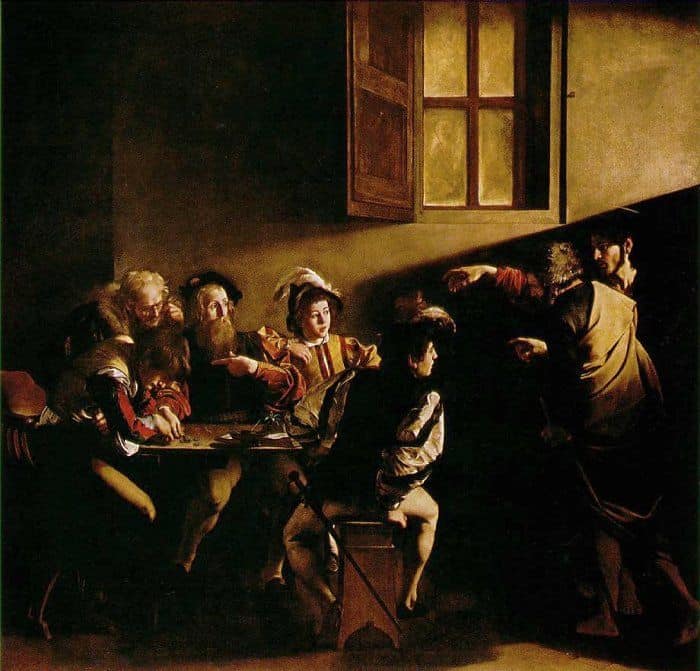
His mastery of shadow and light made him worth the trouble. Look at his work and see how light through a window casts delicate shadows on faces, forearms, even swords. No one in the Renaissance could match that. No one could since.
Rome has nine places to view more than two dozen of Caravaggio’s works. If you idolize him as I do, are just a casual admirer or can’t even pronounce his name (car-a-VAGG-io), use this blog as a guide to explore. Some works are free. Some require a reservation. All can be seen by walking. When you’re finished you’ll see most of the important sites in the most important art city in the world.
Even if you put strolling art museums on a level with shopping, give Caravaggio a try. He may bring out the inner artist in you.
These are in a rough order if you wanted to walk to all of them. If you do, take three days. These museums and churches have more than Caravaggio, and the Vatican Museums are a voyage all their own.

Capitoline Museums, Piazza del Campidoglio 1, open daily 9:30 a.m.-7:30 p.m., 15 euros. Piazza Venezia bus stop. Warning: Campidoglio is a bit of a tourist trap. You may have to weave your way through cell-snapping tourists to negotiate your way up the long, wide, elegant staircase known as the Cordonata. It’s on Capitoline Hill, one of the seven hills of Rome on which the city was founded. It’s worth the effort and you’ll see why tourists flock here. At the top of the staircase is a beautiful piazza designed by the Michelangelo of Renaissance fame and anchored by a statue of Marcus Aurelius, Rome’s emperor during part of its height of power from 161-180 AD (Psst! It’s a copy. The original is in the museum.)
The palaces on the left and right, Palazzo Nuova and Palazzo dei Conservatori, respectively, house the museums, the oldest national museums in Italy. They hold two Caravaggios:
The Gypsy Fortune Teller (1594): More than 400 years ago, gypsies were the lowest form of human life, much as they’re viewed today in Rome. But Caravaggio identified with the gypsies’ desperate nature. The gypsy he paints is attractive, not a vagrant off the street, and wins the customer’s heart before stealing his ring.
St. John the Baptist: Youth with a Ram (1602). Caravaggio did eight paintings of John the Baptist, who baptized Jesus. The ram symbolizes lust, and the boy’s smirky grin fits in well with Caravaggio’s own libido.

Galleria Doria Pamphilj, Via del Corso 305, daily 9 a.m.-7 p.m., 12 euros. Piazza Venezia bus stop. Via del Corso is on any Rome shopping street list. It’s lined with such high-end haberdashers as Ralph Lauren, Elisabetta Franchi and Yamamay. It’s closed to cars on Sunday, turning it into one long pedestrian zone commandeered by shopping bag-wielding warriors. In the middle of the mob is an early 16th century palace with Doric columns framing the tall doorway. Inside is total tranquility where you can escape amongst orange trees and a bubbling fountain.
The collection is from the Doria and Pamphilj families and is considered the largest privately owned gallery in Rome. They include three Caravaggios:
Mary Magdalene (1595): Most artists pictured Mary Magdalene nude as the prostitute she was, or innocently reading a book as the repentant she became. Caravaggio, instead, had her seated low, in the dark, in sorrow. Note the tear near her nose.
Rest on the Flight into Egypt (1597): This comes from the Bible story in which the Holy Family is fleeing to Egypt after hearing Herod the Great, the Roman client king of Judea, was seeking to kill baby Jesus.
Young St. John the Baptist (1602): This is a copy of the one in the Capitoline Museums. But don’t be disappointed. Caravaggio copied many of his paintings.
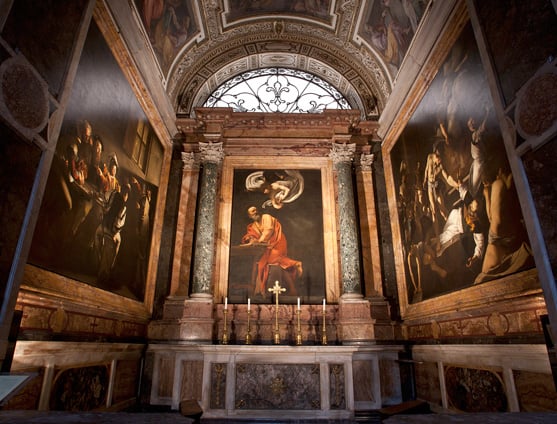
Chiesa di San Luigi dei Francesi, Piazza di San Luigi dei Francesi, Monday-Friday 9:30 a.m.-12:45 p.m., 2:30-6:30 p.m., Saturday 2:30-6:45 p.m., Sunday 11:30 a.m.-12:45 p.m., 2:30-6:45 p.m., free, Senato bus stop. Welcome to THE best bargain in Rome. It’s better than free limoncello from your overly friendly trattoria owner. Here you can find three Caravaggios in a corner of a church, absolutely free. All you need is a 50 centesimi, 1 euro or 2 euro coin to plunk in the box that illuminates the paintings.
This 16th century church was dedicated to, among others, St. Louis IX, the king of France, and is France’s national church in Rome. The Archbishop of Paris is the resident priest. Any francophobes are warned to stay away. You’ll see tons of French tourists.
They’ll be occupied, maybe breathless. So will you. In the far left corner of the church, in the Contarelli Chapel, are three Caravaggio masterpieces:
The Calling of St. Matthew (1600): This is one of Caravaggio’s best illustration of his use of shadow and light. Note how the light from the window illuminates Jesus’ face and the men looking at him as he calls for Matthew to follow him.
The Martyrdom of St. Matthew (1600): This violent painting shows a soldier about to kill Matthew for standing up against an Ethiopian king for sexually harassing his own niece. How much do I like this painting? A print is framed and hanging over my couch.
St. Matthew and the Angel (1602): Caravaggio did eight paintings of St. Matthew. This one is a replacement that was rejected and later destroyed. An angel is beckoning Matthew who seems bothered and in a hurry as you can see by his stool teetering on two legs.

Basilica di Sant’Agostino, Via di Sant’Eustachio 19, daily 7:45 a.m.-noon, 4-8 p.m., free, three-minute walk from Chiesa di San Luigi. This is one of the first churches built in Rome during the Renaissance, in 1483. The travertine rock used in construction was taken from the Colosseum. It houses only one Caravaggio and it is currently on loan to Chiesa Santa Domenica in Northern Italian town of Forno. It returns at the end of June.
Madonna del Loreto (1606): Another Caravaggio painting gets under the church’s skin. He shows Mary barefoot and not very pretty, just like a normal Mary.

Palazzo Barberini, Via delle Quattro Fontane 13, Tuesday-Saturday 8:30 a.m.-7 p.m., 12 euros, Barberini Metro stop. The Barberini name is all over Rome, particularly in this neighborhood north of Termini train station. This spectacular palace was built in 1893 by Pope Urban VIII to celebrate the Barberini family’s rise to power. Bernini and his rival, Borromini, worked on the design. Besides the three Caravaggios, check out the gorgeous painted ceilings.
Narcissus (1599): This is one of two paintings Caravaggio did from mythology. It shows a handsome boy who can’t stop staring at his reflection. According to the Greek myth, even as he is carted off to hell, he still stares at his reflection in the River Styx. It’s where we get the term “narcissism.” We all have a family member who could use this print, don’t we?
Judith Beheading Holofernes (1620): Caravaggio often used prostitutes as models and in this one, a famous courtesan named Fillide Melandroni, is beheading a tyrant.
St. Francis in Prayer (1606): St. Francis’ humility and poverty were a popular theme for Caravaggio who could relate with his troubled life.
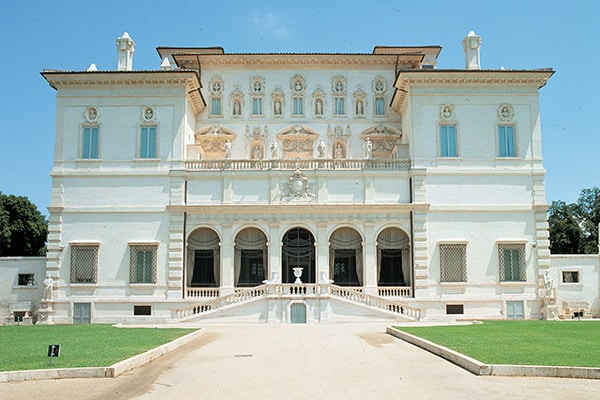
Borghese Museum, Piazzale del Museo Borghese 5, Tuesday-Sunday 9 a.m.-7 p.m., by reservation only, www.galleriaborghese.it, 39-06-32810, entries 9 a.m., 11 a.m., 1 p.m., 3 p.m., 5 p.m., 15 euros, Pinciana/Museo Borghese bus stop. This is my favorite museum in Rome. It has all the great Italian masters from Bernini to Raphael to Botticelli. Cardinal Scipione built it in the early 17th century to house his art collection and Prince Marcantonio Borghese did a renovation a century later. It’s not too big that you’ll get exhausted. It’s just big enough to take in leisurely in the two-hour viewing sessions. Also, the 198-acre Villa Borghese park where it sits is a great place to have a pre-museum picnic.
The Borghese has the most Caravaggios in Rome. Here are the three main ones:
Young Sick Bacchus (1594): Caravaggio painted this shortly after he arrived in Rome from Milan in 1592. He painted it using a mirror to illustrate his own horrific ailment, probably malaria, that put him in the hospital for six months.
Madonna and Child with St. Anne (1606): The child kills the snake representing Satan. St. Peter’s rejected it because of Caravaggio painting Madonna with huge breasts. I had this copy on my wall in Denver. (I’m not a breast man. I just loved the satanic imagery.)
David with the Head of Goliath (1610): Look at the inscription on David’s sword: “H-AS OS.” It stands for the Latin phrase, “Humilitas occidit superbiam.” (Humility kills pride.) Note the humble look on David’s face.
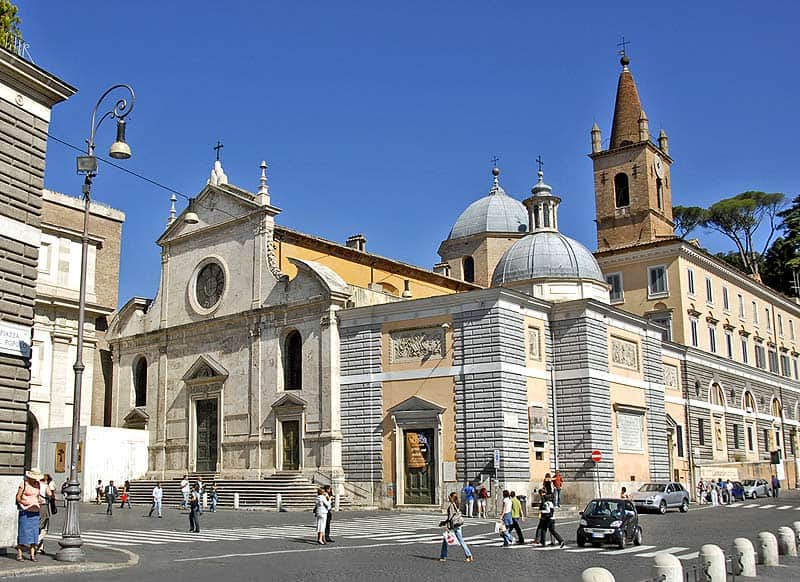
Chiesa di Santa Maria del Popolo 12, Piazza del Popolo daily 7 a.m.-noon, 4-7 p.m., free, Flaminio Metro stop. In one of the most famous piazzas in Rome, near the gate where triumphant Roman armies re-entered the city, the church was built in 1477. It was one of the first churches Rome visitors saw. On the wall facing the church, see the plaque depicting the church’s last beheading, which took place in the piazza in 1825.
The Conversion of St. Paul (1601): Like the accompanying Crucifixion of St. Peter, this was first rejected for reasons that remain unclear. But it depicts Saul of Tarsus who’s blinded by brilliant light while on his way to Damascus to slaughter its Christian community.
The Crucifixion of St. Peter (1601): Peter did not want to imitate Jesus’ crucifixion. Thus Caravaggio had him crucified upside down.
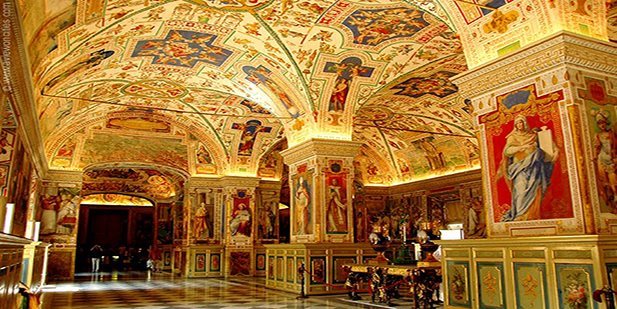
Vatican Museums, Viale Vaticano, daily 9 a.m.-6 p.m., last Sunday of month 9 a.m.-2 p.m., 17 euros without online booking, 21 euros with Skip the Line online booking, http://mv.vatican.va., free last Sunday of month, Ottiviano Metro stop. You’ll need a whole day to see this. It has 13 ½ acres of art, making it what’s considered the largest art collection in the world. Hint: To see the Sistine Chapel, head straight for it and work your way back. If you see every painting between the entrance and the chapel, you’ll be too dead to look up.
However, the Vatican has only one Caravaggio which tells you something about how he alienated the church. It’s in the Pinacoteca museum, an underrated papal picture gallery.
Deposition from the Cross (1604): Considered one of his greatest masterpieces, this is one of the only works depicting Jesus getting placed on the stone upon which he’ll be entombed. Rubens and Cezanne later copied the work.

Galleria Corsini, Via della Lungara 10, Wednesday-Monday 8:30 a.m.-7 p.m., 12 euros, Lungotevere Vallati/Pettinari bus stop. Located in the once-Bohemian-now-trendy neighborhood of Trastevere, Corsini doesn’t get much foot traffic. The Corsini family built the Baroque palace in 1740 a dead carp’s throw from the Tiber River.
St. John the Baptist (1606): Caravaggio strength in realism shows through more than anywhere here. It shows the famous saint as a young man, looking disheveled with “boy band hair” as if he just woke from a bender.
(Bonus tip: Caravaggio’s old apartment and the street where he murdered his rival are one minute apart. His apartment, marked by his giant portrait, is on Vicolo del Divino Amore near Piazza Navona. Around two short corners on Via di Pallacorda is the site of an old tennis court where he killed an enraged Ranuccio Tomassoni in 1606, which sent Caravaggio running from the law until his death in 1610.)



March 9, 2018 @ 6:33 am
This is excellent John! Indeed, I agree that among the wonders and treasures of Rome, the San Luigi dei Francesi church must be counted, where one can just cruise in and view 3 Caravaggios. I hope that the world will remain safe enough and respectful enough that such treasures can remain.
March 9, 2018 @ 11:04 am
And don’t forget Caravaggio’s only fresco housed in Villa Aurora, A few blocks from the U.S. Embassy. Check information on Google when this privately own home can be visited. The current owner is in poor health, which may restrict visits. The fresco created for a cardinal who dabbled in alchemy is marvelous. Pictures of it are on-line as well.
March 10, 2018 @ 12:32 am
Thanks for the note, Dick. I had no idea about Villa Aurora. Will put it on my list.
March 10, 2018 @ 9:58 am
Hi John.
Was Caravaggio cera long lived? You have him dying in 2010!! I presume 1610.
Apart from that little detail, what an interesting article. I will make tracks to Vicolo del Divino Amore and Via di Pallacorda next time i get to Rome.
March 11, 2018 @ 12:41 am
I visit San Luigi dei Francesi every time I am in Roma. I need to get to Galleria Borghese one of these days. Great article! Cristina
June 24, 2019 @ 7:15 am
Thank you for the reviews I am also an admirer of Caravaggio. I have seen his at Villa Borghese in Rome and some in London National Gallery and his at a church in Sicily where he eluded the prosecution. I plan to see some more next time I am in Rome.